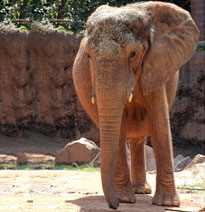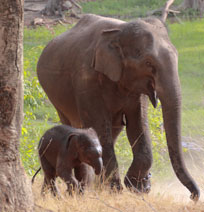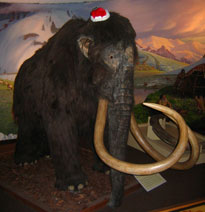Proboscidea -- Elephants are the Largest Land Mammals



Origins
This order has always been a bit on the large side. The living species are the largest animals on land. The name proboscidae is derived from its pronounced upper lip and nose. Elephant ancestors arose about 50 million years ago, spread out to about 350 species and became fairly large among grass-eaters. Their ancestors all had rather pronounced upper lips. The present species have evolved to eat and digest the toughest of vegetation with the help of their massive trunk and giant tusks. However, it is hypothesized that the massive size that gives them a specialized niche also contributed to most species declining precipitously. The slow reproduction rates among these pachyderms have not helped them either.
There is evidence in cave paintings and drawings that man was aware of mammoths and mastodons and probably hunted them for food. Both of these became extinct at the end of the last ice age. Coincidentally, populations of humans exploded around that time too. This leads some experts to suggest that we hunted them to extinction. The way things are going in the wild these days, with ivory poachers doing brisk business, we might polish off the remaining members of this order in a short time too. That would be a sad day not only because these creatures are so unique but because they form the basis of very many ecosystems in the savannah.
Physical Characteristics
This is where the parable of the six blind men and the elephant starts to make sense. It is impossible to describe in just a few words, all the amazing adaptations that this order has contrived to come up with. We will have to take each body part in turn.
Trunk
This amazing fusion of the upper lip and nose helps the animal in many ways. It is used as a periscope to smell any dangerous predators lurking nearby. It is made up of upto 100,000 individual muscles so it acts exactly as a hand would for us humans. They use it to get food into their mouths. Elephants use this trunk as a giant handheld shower and also use it to put water into their mouths. This appendage can hold upto 4 gallons or 14 liters of water at a time. Elephants will also use their trunks for social interactions among herd members. Intertwining trunks is like a friendly handshake for an elephant.
Teeth/Tusks
Elephants are strictly herbivorous and most of the work is done by the massive pair of molars on each jaw. Over the life of an elephant they usually have six pairs of molar that grow one after another. They have some fearsome looking tusks that are used for defense ( and offense if need be). These tusks are also used to dig for tubers, and scrape bark off trees. Elephants are also known to use these tusks to maul other animals, particularly pesky humans that dare to stray too close to their calves.
Skin/Ears
An elephant is the proud owner of a very thick skin, hence the term pachyderm. However, the skin is also very sensitve and needs to be kept moist and disinfected as the chances of infection are rather high on the savannah. To this end, elephants need ready access to water where they can wallow in it for a while to cool off; then they powder themselves with mud so that sunlight and insects will not irritate their skin as much.
An elephant's ears are made of very thin layers of skin and a lot of blood vessels radiate in this area so that by flapping their ears the blood can cool a little in the harsh warmth of the shade-less savanna sun. This is adaptation to regulate body heat is fairly unique to elephants.
Legs/Feet
Elephants, like their cousins the hyrax, walk on their toes(plantigrade). The area between and behind the toes is made up of rounded and cushioned tissue. The legs are like pillars to enable the animal to stand for long periods without tiring. Due to their bulk, elephants cannot really jump around, however they can achieve speeds of upto 40 Km/hr when they walk at a faster pace.
Geographic Distribution
View Larger Map
Elephants are found in patches all over Africa and Asia. They have been heavily threatened and their habitats have been severely eroded in large parts of their historic range. At the time of writing, you would be hard-pressed to see elephants anywhere outside national parks. In India and further East, elephants have been used as temple chariots to carry the Gods around on auspicious days. Elephants were also extensively used in the logging industry before heavy equipment became an easier substitute.
Reproduction
Elephant calves are born blind after a 22 month pregnancy. They rely on their mother and "aunts" of their tribe to guide them through their very long childhood. Female elephants live in a herd headed by a matriarch who guides them through their feeding and migrating grounds through-out the year. When babies present the matriarch's tend to be very touchy and don't let anyone aside from the herd approach the little one. Elephants do not reach adulthood until they are well into their teens. This is an unusally long period of childhood among mammals. The only parallels to this are seen among humans.
Feeding Habits
Elephants are herbivores, spending upto 16 hours a day collecting plant food. They eat mostly grass and supplement it with fruit, bark,leaves and any other vegetation they can get their trunks around. Elephants can only digest about half of what they eat, so they have to make up for it in volume. They eat so much that in a zoo you can see the keepers carting around elephant dung in wheelbarrows!
Videos